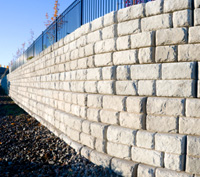
Build a retaining wall

A 'retaining wall' is a structure erected to support an excavated or filled embankment. If you are proposing to build a retaining wall, find out if you need planning and/or building approval.
Planning approval
A Development.i property enquiry can help you determine if the proposal requires Council approval. You can also phone 07 3403 8888 to speak to a town planner.
No development application required
In all zones, you do not need a development application if your proposed retaining wall is less than one metre high.
If your proposed retaining wall does not meet these requirements, you may need a development application. Contact Council for advice specific to your retaining wall.
Other circumstances when a development application may be required
Contact Council for specific advice if your proposed retaining wall is:
- located on a site covered by the:
- located on a site subject to the:
- associated with the development of a dwelling house on a small lot
- associated with the subdivision of a site, particularly a site with a slope
- associated with the filling or excavation exceeding thresholds identified in the filling and excavation code.
Building approval
A retaining wall is a 'class 10b' (non-habitable) structure under the Building Code of Australia (forming volumes one and two of the National Construction Code).
Queensland building regulations advise you will not need building approval for a retaining wall if:
- there is no 'surcharge loading' over the 'zone of influence' for the wall (refer to definitions in the Building Regulation 2006 (Schedule 1 Section 3))
- the total height of the wall and of the fill or cut retained by the wall is no more than one metre above the wall's natural ground surface
- the wall is no closer than 1.5 metres to a building or another retaining wall
- it does not form part of the fencing for a pool.
If your project does not meet all requirements, you must prepare a building application for building certifier approval. You must give the certifier scaled and detailed plans prepared by a draftsperson or architect.
The Queensland Development Code recommends you construct retaining walls up to one metre, requiring fill or excavation, in accordance with an accepted industry standard publication, depending on the materials used to construct it (e.g. timber, concrete masonry). The code also requires minimum clearances from roads and side and rear boundaries. Your certifier can seek an alternative setback from the front, side or rear boundary by applying for a siting variation.